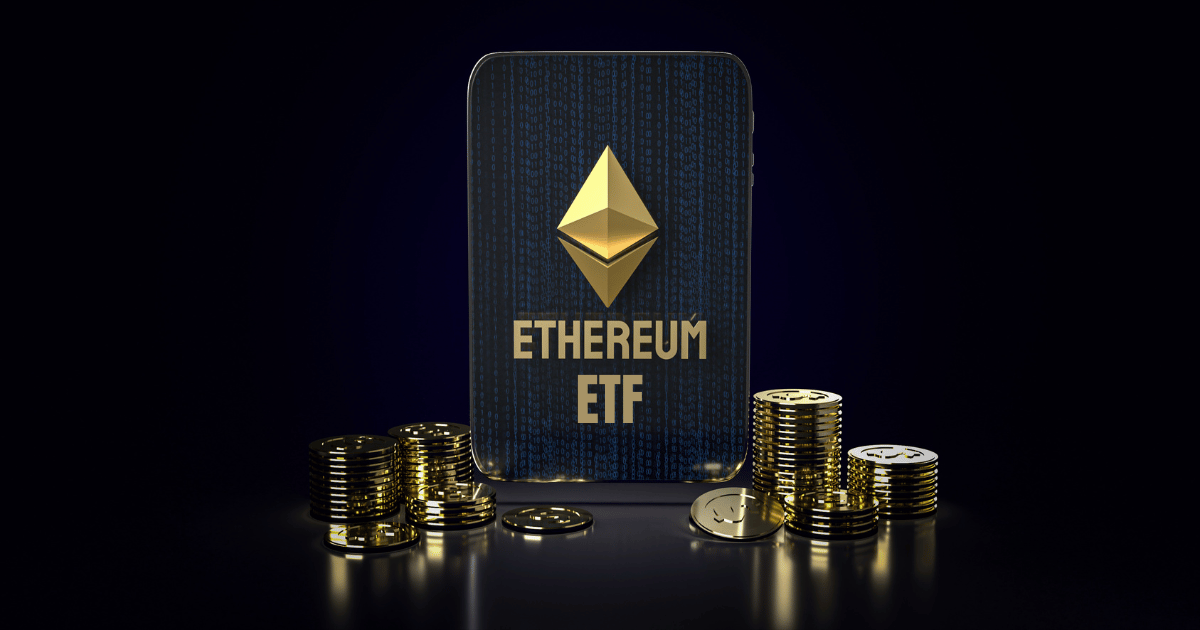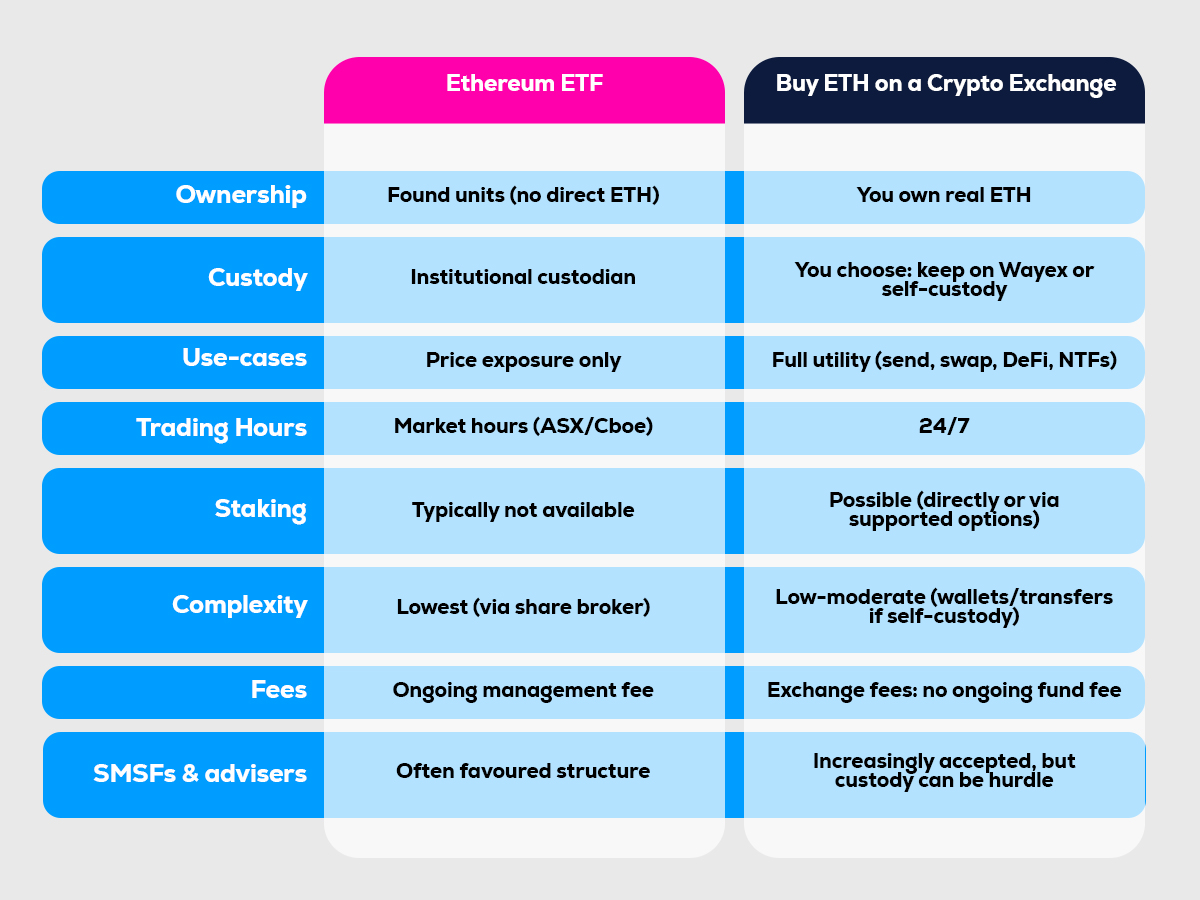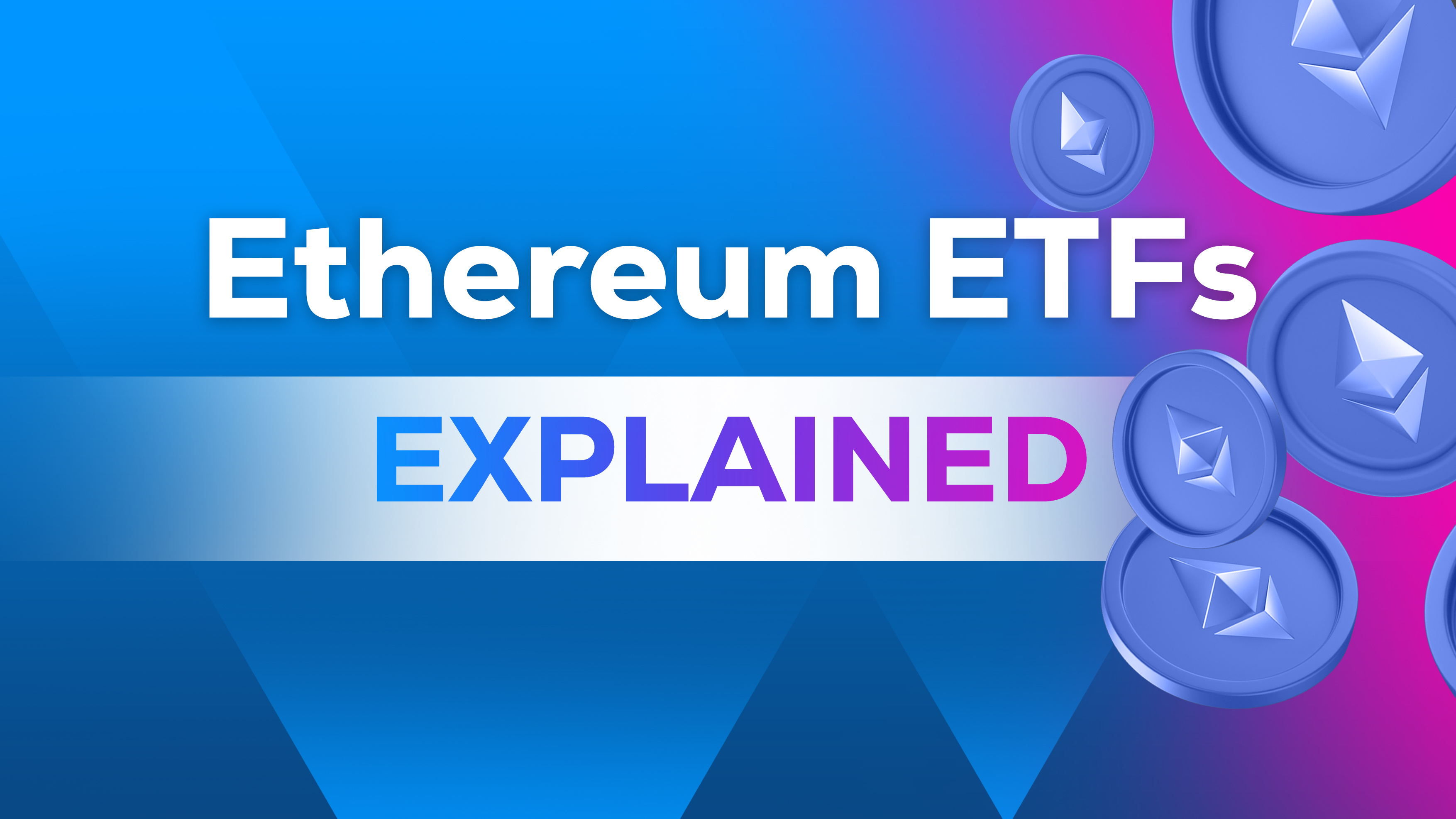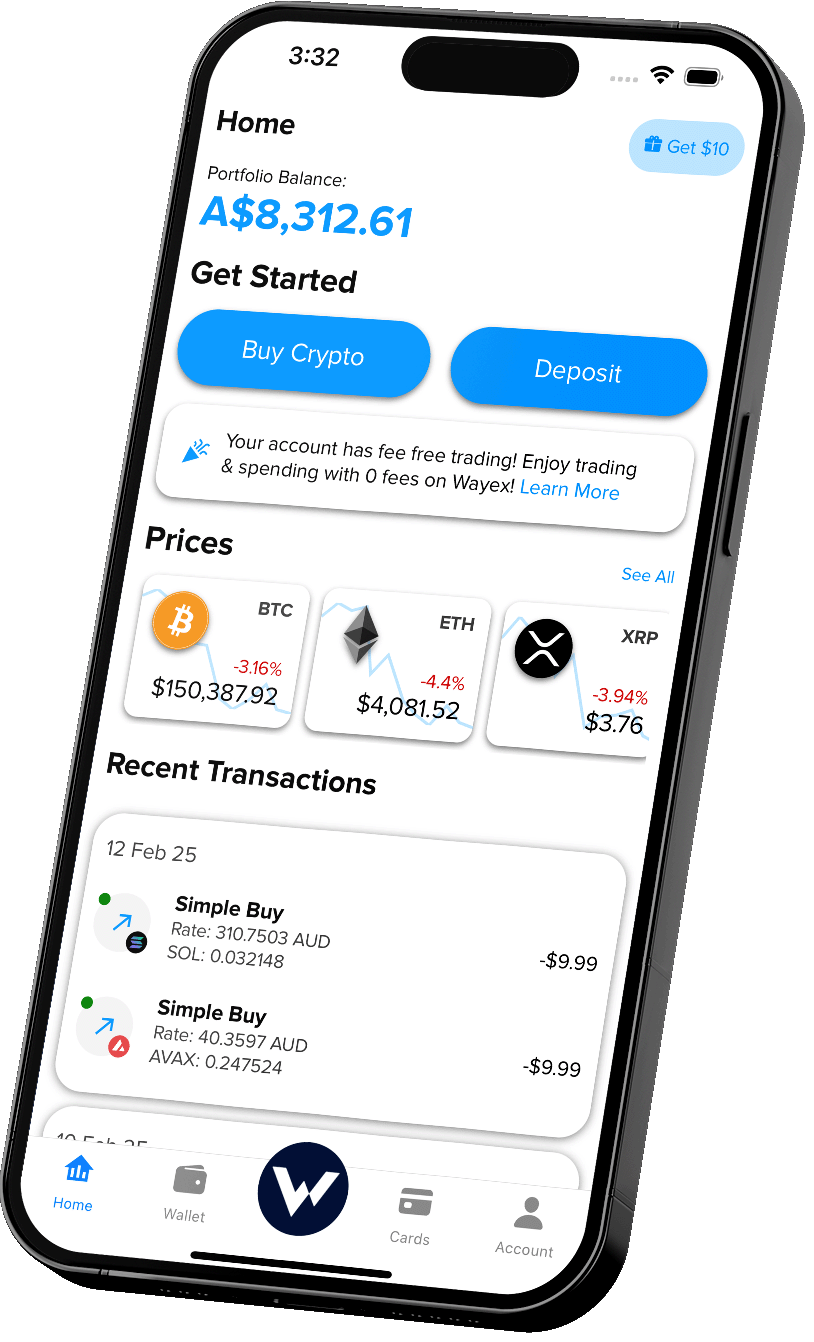TL;DR: Ethereum ETFs let you get exposure to ETH through the stock market, without the hassle of managing wallets or private keys. They’re convenient and regulated, but you don’t actually own ETH, and you miss out on things like direct ownership of your crypto and earning yield from holding ETH. For some investors, buying ETH directly on a crypto exchange like Wayex still makes more sense. Here’s how to decide.
What is an ETF?
An Exchange Traded Fund (ETF) is a regulated investment product you buy and sell through a stockbroker, much like buying and selling shares. For crypto beginners, an Ethereum ETF can be a more accessible first step than buying ETH directly.
Unlike purchasing crypto on an exchange like Wayex, an ETF doesn’t require you to set up a crypto wallet or manage private keys. You buy ETF units through your regular share-trading account, and the fund manager handles the crypto on the back end.
With a crypto ETF, you don’t own the coins themselves. Instead, you own units in a fund that tracks ETH’s price. Traditional ETFs usually hold baskets of shares; crypto ETFs typically hold a single asset (e.g., Bitcoin or Ethereum). This lowers the barrier to entry and has helped more retail and institutional investors get comfortable with crypto exposure.
How Ethereum ETFs work (in plain English)

There are two primary structures for Ethereum ETFs:
→ Spot (physical)
→ Futures.
Understanding the difference helps you grasp what you're actually investing in:
Spot (physical) ETFs: These funds own real ETH tokens, stored in institutional-grade custody, and aim to mirror Ethereum’s market price minus a small management fee. Because you're tracking real assets, spot ETFs are generally more transparent and predictable in terms of tracking accuracy. As Forbes explains, a spot ETF "reflects the real-time value of the asset" by holding it in reserve.: These funds invest not in ETH itself, but in
Ethereum futures contracts, which are agreements to buy or sell ETH at a predetermined price on a set future date. This introduces a layer of complexity, and funds must continually "roll" expiring contracts into new ones, creating costs (known as contango) and potential divergence from the actual spot price.
In Australia today, available Ethereum ETFs are overwhelmingly spot-based, meaning they hold ETH outright. These are listed on major exchanges like the ASX (Australian Securities Exchange) and Cboe Australia, and are bought and sold during regular market hours just like any other shares.
Why should I buy Ethereum ETF?
Simplicity: No wallet setup, seed phrases, or on-chain transfers. Just buy through your stockbroker.
Regulated wrapper: Listed on a stock exchange, with a Product Disclosure Statement/Target Market Determination and institutional custody.
Portfolio fit: Easy to hold in the same account as your shares, often compatible with platforms and advisers. Many Self-Managed Super Funds (SMSFs) prefer ETFs over direct coin custody.
Admin & tax ease: One line item, annual statements from the fund, and familiar Capital Gain Tax (CGT) treatment on units you sell.
The trade-offs you should know before investing

You don’t control the ETH. No self-custody, no on-chain use (DeFi, NFTs, transfers), and typically no staking yield.
Fees exist. Management fees slightly reduce long-term returns versus holding ETH directly.
Market hours only. ETFs trade when the stock market is open, whereas crypto trades 24/7. Therefore, ETFs can “gap” on Monday, opening after the weekend moves.
Tracking & liquidity. Smaller funds can have wider spreads; futures-based funds (overseas) can track less precisely.
What Does “Gap” Mean? In stock markets, a gap occurs when the opening price is higher or lower than the last closing price, with no trades in between. Since ETFs only trade during market hours, they can’t adjust in real-time like crypto does. Therefore, if ETH moves drastically over the weekend, the ETF price may “jump” on Monday’s open to catch up.

Rule of thumb:
If you want hands-off, regulated, brokerage-only exposure, an ETF ticks boxes.
If you want true ownership, 24/7 flexibility, and on-chain features, buy ETH directly on a crypto exchange like Wayex and transfer to a cold wallet like Ledger.
Learn more about cold storage through our Wayex Academy.
Best Ethereum ETFs for Australians in 2025
Australia was one of the first countries to allow spot Ethereum ETFs, and this meant that funds can actually hold ETH in custody rather than just futures contracts.
This distinction is important because spot ETFs tend to mirror ETH’s real market performance more closely, while futures-based funds can lag due to extra costs and rolling contracts.
Today, there are several options listed on both the ASX and Cboe Australia
(1) Global X 21Shares Ethereum ETF (EETH)
- Launched in May 2022 on Cboe Australia.
- Holds ETH in cold storage custody with Coinbase.
- Management Costs of 0.45% p.a.
Read more on Global X EETH
(2) Monochrome Ethereum ETF (IETH)
- Launched in October 2024 on Cboe.
- Australia’s first crypto ETF managed by a home-grown asset manager.
- Uses BitGo and Gemini for custody; recently cut fees to 0.25% p.a.
Read more on Monochrome IETH
(3) BetaShares Ethereum ETF (QETH)
- Launched in February 2025 on the ASX.
- Gives exposure to ETH via an underlying U.S.-listed spot fund.
- Management fee around 0.45% p.a.
Read more on BetaShares QETH
How they work: All of these ETFs are spot products, which means they hold ETH in institutional custody accounts. They don’t use leverage, and they aim to track ETH’s market price (minus small management fees).
How to invest in Ethereum ETF?
You can purchase ETF units the same way you’d buy shares:
(1) Log in to your brokerage or share-trading account (e.g., CommSec, SelfWealth, etc.).
(2) Search for the ETF ticker (e.g., EETH, IETH, or QETH).
(3) Place a buy order during market hours.
Fees and Accessibility
Each ETF charges an annual management fee (ranging roughly from 0.25% to 0.50%). This is taken out of the fund’s assets rather than billed to you directly.
Some investors prefer Cboe ETFs (EETH, IETH) because they were early movers with a simple 1:1 ETH backing.
Others may prefer ASX-listed ETFs (QETH) for the liquidity and visibility of being on the main exchange.
Risks to keep front of mind
Like any investment, Ethereum ETFs carry risks. Here are the key ones to be aware of:
(1) Volatility: Ethereum’s price can swing sharply in short periods. Position sizing is critical, as even small allocations can create large fluctuations in your portfolio. Track ETH’s price on Wayex.
(2) Product risk: Smaller ETFs may have lower trading volumes, leading to wider bid/ask spreads. This can increase the cost of buying or selling units compared to larger, more liquid funds.
(3) Counterparty and custody risk: With an ETF, you rely on the fund manager and its chosen custodian to safeguard the ETH. Always read the Product Disclosure Statement (PDS) of the fund, to understand who is responsible for custody and what protections are in place.
(4) Regulatory change: Crypto regulation is still evolving. Rules around ETFs, custody, or taxation could change over time, and it’s important to stay informed through updates from ASIC and your ETF provider.
Quick FAQs
Do I own ETH if I buy an ETF?
No. You own fund units that track ETH’s price.
Can I stake through an ETF?
Generally no. Most funds don’t pass staking rewards to holders.
Can my SMSF buy ETH?
Yes, either via approved ETFs (often simpler for trustees) or by buying ETH on Wayex if your deed and policies allow. Get professional financial advice first.
Are ETFs “safer” than holding coins?
They remove self-custody risks, but you still face market volatility and product/custody dependencies. There are other risks to consider, so it's not completely risk-free.
Choose the path that matches your goals

Pick an ETF if you want pure price exposure inside a familiar brokerage account, without the need to manage wallets or private keys.
Buy ETH directly on an exchange if you value ownership and utility: sending funds, on-chain use, optional self-custody, and 24/7 crypto market access.
Both approaches carry risks, and both have their own advantages. Whichever you look into, it’s wise to start small, think long term, and only invest what you can afford to fluctuate
Final thought
Ethereum ETFs make ETH exposure possible through the stock market, while buying ETH directly on Wayex gives you true ownership and utility.
Both have their place, and it depends on whether you want a regulated ETF structure or the flexibility of holding ETH yourself.
👉 If you’d like to learn more about buying ETH directly on Wayex, visit our Ethereum page and fees page.
👉 If you’d like to explore ETFs, check the ASX or Cboe Australia websites for current listings, and always read the PDS/TMD before investing.
**All information in this article is for informational purposes only. You should not construe any such information or other material as legal, tax, investment, financial, or other advice. Nothing contained herein shall constitute a solicitation, recommendation, endorsement, or offer by Wayex to invest, buy, or sell any coins, tokens, or other crypto assets. Any descriptions of Wayex products or features are merely for illustrative purposes. Past performance is not a guarantee or predictor of future performance. The value of crypto assets can increase or decrease, and you could lose all or a substantial amount of your purchase price. It is essential for you to do your research and due diligence to make the best possible judgement, as any purchases shall be your sole responsibility.










